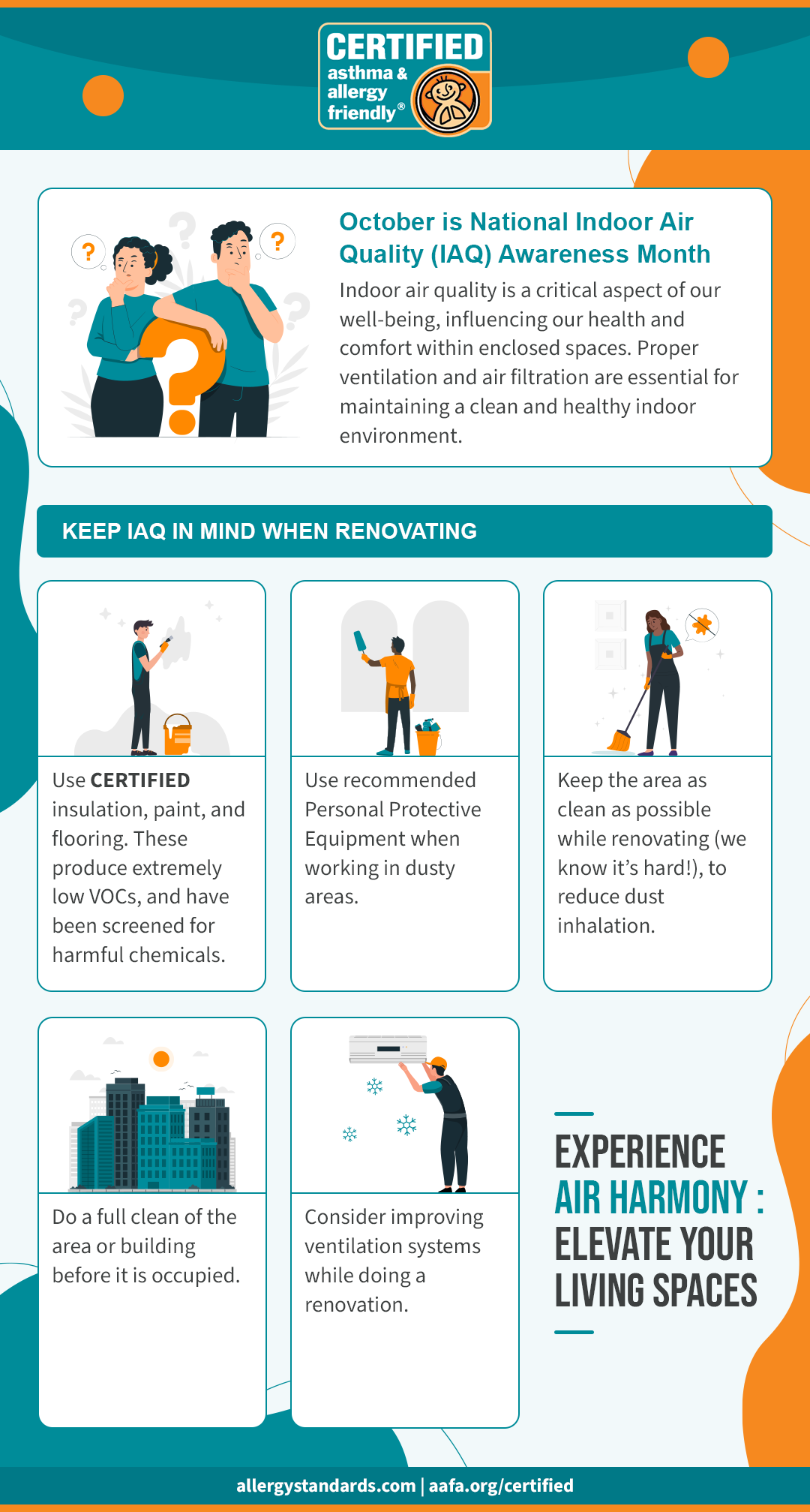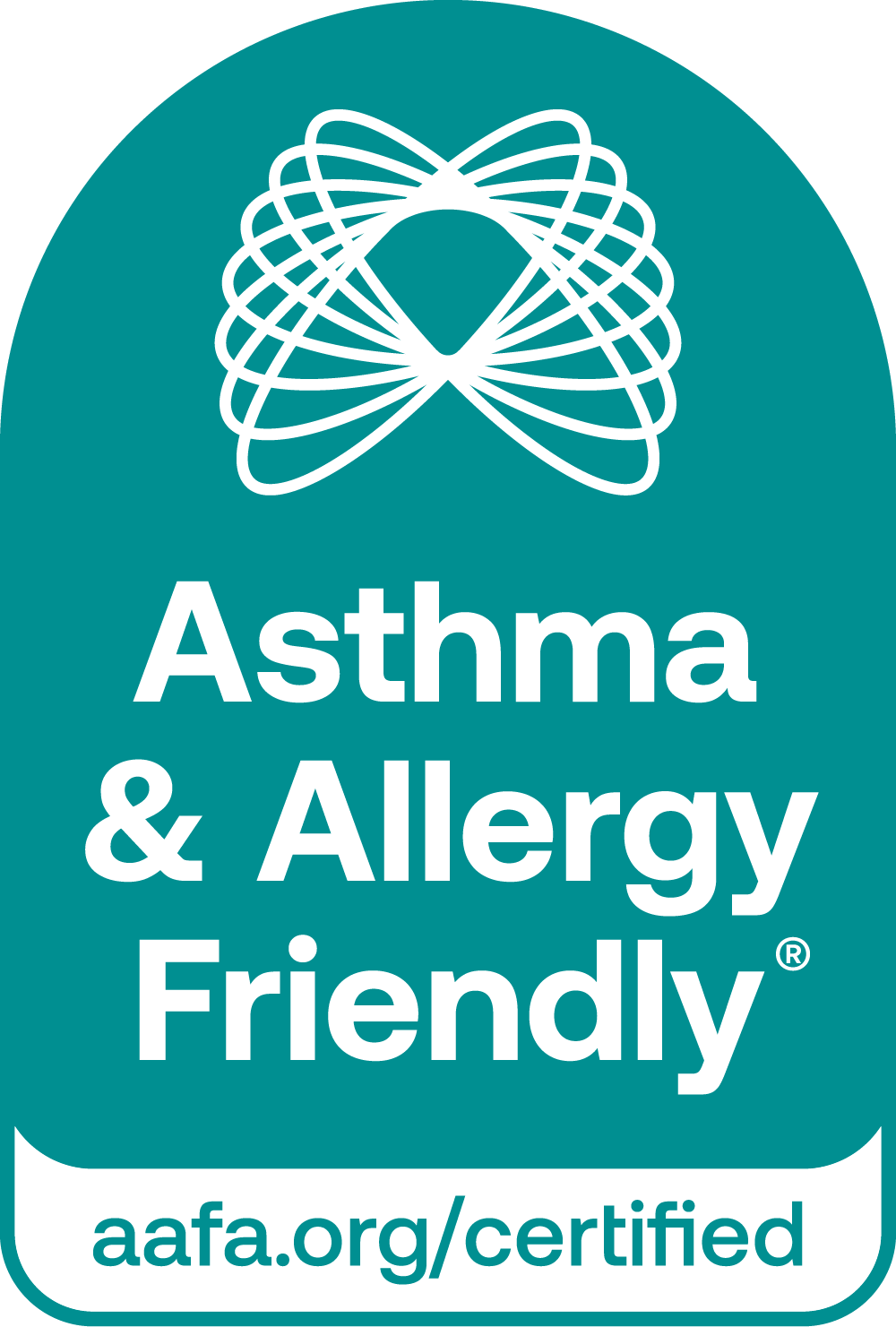Renovating for better indoor air quality, incorporating Asthma & Allergy Friendly® Certified products, ensures a healthier environment for everyone in the household.
Renovating your home offers a unique opportunity to enhance not only the aesthetic and functionality of your living space but also to improve indoor air quality (IAQ) for the whole household. October, recognized as Indoor Air Quality Month, highlights the importance of IAQ, especially for those affected by asthma and allergies. During renovations, the choices you make can have a lasting impact on the air you breathe indoors, benefiting everyone in the household.
Indoor air can be two to five times more polluted than outdoor air, according to the U.S. Environmental Protection Agency (EPA). This is particularly concerning for those with asthma and allergies, as pollutants such as dust mite allergen, pet dander, mold, and volatile organic compounds (VOCs) can trigger symptoms. But, by incorporating Certified Asthma & Allergy Friendly® products into your renovation, you can ensure a healthier home environment. This article explores how renovations offer an opportunity to improve IAQ in key areas such as paint, flooring, insulation, HVAC filters, whole home air cleaners, laundry appliances, and bedding.
Why Indoor Air Quality Matters for Health
The quality of the air we breathe indoors plays a crucial role in our overall health. Poor IAQ can lead to a range of health issues, from minor discomforts such as headaches and fatigue to more serious respiratory conditions like asthma. For individuals with allergies, exposure to indoor allergens can exacerbate symptoms, resulting in sneezing, coughing, and difficulty breathing. Indoor air can contain a mix of airborne particles, chemicals, and biological contaminants, which is why it’s essential to consider IAQ during home renovations.
According to the Asthma and Allergy Foundation of America (AAFA), allergens and pollutants in the home can trigger asthma attacks and exacerbate allergic reactions. Improving IAQ is not only beneficial for individuals with respiratory issues, but it also promotes a healthier environment for everyone in the home. By integrating Certified Asthma & Allergy Friendly® products into your renovation, you can reduce the presence of allergens and irritants in your home.

Renovating for Better Indoor Air Quality
Renovating for Better Indoor Air Quality: Paint
Paint is often a go-to item during renovations, but it can be a significant source of indoor air pollution. Conventional paints can emit VOCs, which are potentially harmful chemicals that can cause eye, nose, and throat irritation, headaches, and long-term damage to the liver, kidney, or central nervous system.
When choosing paint for your renovation, opt for Certified Asthma & Allergy Friendly® paint. These paints undergo rigorous testing to ensure they emit low levels of VOCs, making them a better choice for indoor air quality (IAQ). They are also evaluated for performance and the quality of their constituent materials to meet high standards of effectiveness. Certified paints are tested not only for initial VOC emissions but also over time to ensure that they continue to support healthier indoor air long after the renovation is complete. Using these products helps reduce the risk of exacerbating asthma or allergy symptoms while still achieving the desired look for your home.
Renovating for Better Indoor Air Quality: Flooring
Flooring plays a significant role in indoor air quality (IAQ) as it can either contribute to or mitigate the presence of allergens and pollutants. Some flooring materials release VOCs, which, as we know, can lead to respiratory issues and other health risks. Additionally, flooring can trap allergens like dust, pet dander, and pollen, which can become airborne when disturbed. Hard-surface flooring, while less likely to trap allergens, still requires careful maintenance. Moisture in certain types of flooring can also promote mold growth, further impacting IAQ, especially for those with allergies or asthma. Regular cleaning is crucial to prevent the accumulation of dust and particulate matter, which can be stirred up by foot traffic and degrade air quality.
The Asthma & Allergy Friendly® Certification Program certifies flooring by conducting rigorous testing to ensure it supports healthy indoor air quality. It measures VOC emissions from flooring materials and adhesives over time, ensuring they stay within strict safety limits. The program also tests how effectively flooring can be cleaned, requiring thatstandard cleaning methods can remove at least 90% of allergens from the flooring surface and ensures that cleaning doesn’t release more allergens into the air. Additionally, flooring must maintain its durability and ease of cleaning over time. Both resilient and soft surface flooring are certified, with soft surface flooring tested to ensure at least 75% of allergens can be removed through standard cleaning methods while minimizing airborne particles, allowing for comfort without sacrificing air quality.
Renovating for Better Indoor Air Quality: Insulation
Insulation plays a crucial role in regulating temperature, but it can also impact IAQ. Poorly installed or low-quality insulation can harbor mold, dust, and other irritants, especially in damp or humid areas. Choosing Certified Asthma & Allergy Friendly® insulation ensures that the insulation material used in your home renovation supports a healthy indoor environment. These certified products are designed to suppress mold growth, reduce VOC emissions, and minimize the risk of airborne irritants that could exacerbate asthma or allergy symptoms.
Renovating for Better Indoor Air Quality: HVAC Filters and Whole Home Air Cleaners
HVAC filters play a crucial role in improving indoor air quality by trapping airborne contaminants like pollen, dust mite allergens, and pet dander, reducing asthma and allergy triggers in the home. Again, when selecting a filter for HVAC systems, it’s important to choose one that has been independently tested and validated for effectiveness. The Asthma & Allergy Friendly® Certification Program offers this assurance by subjecting filters to rigorous testing to ensure they meet strict standards for allergen reduction and overall air quality improvement.
Beyond allergen reduction, the certification program tests filter performance when loaded with dust, a common issue that can reduce effectiveness and increase energy consumption. The Asthma & Allergy Friendly® Certification Program ensures that even under these conditions, filters maintain airflow efficiency. Additionally, the integrity of filter seals is tested to prevent air and particles from bypassing the filter.
Whole home air cleaners can also be installed in the ductwork of your central air system to further improve IAQ throughout the entire home. Certified whole home air cleaners undergo strict testing to ensure they reduce allergens without emitting potentially harmful levels of ozone.
Renovating for Better Indoor Air Quality: Laundry Appliances
Laundry is often overlooked as a factor in IAQ, but your laundry habits and appliances can play a significant role in maintaining a healthier home environment. Dust mite allergen, pet dander, and pollen can cling to clothing, bedding, and other textiles, making laundry appliances an essential tool in allergen reduction.
Certified Asthma & Allergy Friendly® laundry appliances help support a healthier indoor environment by meeting strict standards in several key areas. These machines are tested for their ability to effectively reduce seeded allergens, and reach and maintain washing temperatures of 130°F or higher, conditions known to eliminate house dust mites.. Additionally, they are evaluated to ensure they meet these requirements without exposing users to concerning levels of ozone, making them an effective choice for allergy and asthma management.
General Advice for Better Indoor Air During Renovations
While incorporating Certified products into your renovation is an excellent way to improve IAQ, there are additional steps you can take to protect your indoor air during the renovation process:
- Ensure Adequate Ventilation: Proper ventilation is essential during renovations, especially when using paints, adhesives, or other materials that emit VOCs. Open windows and doors when possible, and use fans to circulate fresh air throughout the space.
- Use Personal Protective Equipment (PPE): Renovations can generate airborne dust, mold spores, and other particles. Wearing masks and other PPE can help prevent the inhalation of harmful particles during the renovation process.
- Keep Renovation Areas Clean: Dust and debris can accumulate quickly during renovations. Regularly clean the work areas to minimize dust and allergens, and use Certified Asthma & Allergy Friendly® cleaning products.
- Thoroughly Clean Before Occupying: Once the renovation is complete, it’s essential to thoroughly clean the space before occupying it. This ensures that dust, debris, and other allergens from the renovation process are removed, leaving a healthier indoor environment.
Conclusion
Renovating your home presents a valuable opportunity to improve your indoor air quality, both in the short-term and the long-term, creating a healthier environment for everyone in the household. By incorporating Certified Asthma & Allergy Friendly® products into your renovation plans—whether in paint, flooring, insulation, HVAC filters, air cleaners, laundry appliances, or bedding—you can significantly reduce allergens and irritants, ensuring enhanced indoor air quality.
Indoor air quality is a priority for those with asthma and allergies, but creating a healthier home benefits everyone. As we mark October Indoor Air Quality Month, consider the choices you can make during your next renovation to support better IAQ and a healthier future for your home.
